It looks like you're using an Ad Blocker.
Please white-list or disable AboveTopSecret.com in your ad-blocking tool.
Thank you.
Some features of ATS will be disabled while you continue to use an ad-blocker.
share:
 We may now be one step closer to solving an ancient mystery that has baffled
archaeologists from around the world for ages. Many of us have always wondered just how the magnificent builders of ancient cultures managed to work
with megalithic stones in such a way that we still marvel at their precision and execution up to this very day.
Puma Punku is one of those places where incredible megalithic artwork can be found and we may now
have the evidence to prove that the ancients were capable of softening stone with a method unknown to us today.
We may now be one step closer to solving an ancient mystery that has baffled
archaeologists from around the world for ages. Many of us have always wondered just how the magnificent builders of ancient cultures managed to work
with megalithic stones in such a way that we still marvel at their precision and execution up to this very day.
Puma Punku is one of those places where incredible megalithic artwork can be found and we may now
have the evidence to prove that the ancients were capable of softening stone with a method unknown to us today. With this thread I'm combining two relatively recent findings to make a compelling case for the use of molding and stone softening techniques at Puma Punku in ancient times. One of these findings comes from the field of material sciences using electron-microscopic analyses (spoiler alert: the stone surfaces show no signs of abrasion through cutting tools) and the other one involves a very practical molding experiment which strongly suggests that the ancients used molds in combination with an unknown geopolymer cement that, to this day, has fooled us into believing we're looking at natural stone instead of man-made material.

If you're more interested in the purely scientific investigation I would suggest you go directly to the second post further below. But for now let's start with the experimental part and have a look at what molding specialist Ewald Schuster has found when he inspected Puma Punku.
PART 1: OBSERVATIONS AND EXPERIMENTS BY EWALD SCHUSTER
When Ewald Schuster visited Bolivia he made a quite remarkable observation: despite the overall precision of the stones at Puma Punku, he did notice some minor flaws and some telltale signs indicative of the method that was likely applied by the ancient builders. Three examples help illustrating what Schuster means: the first one is a slight inaccuracy on the inside corner of one of the many blocks that can be found at Puma Punku. When looking closely one notices some excess material left behind in a corner that otherwise features precise geometry. It is barely visible on the photo below but when inspecting the contours of the corner, you'll see it.
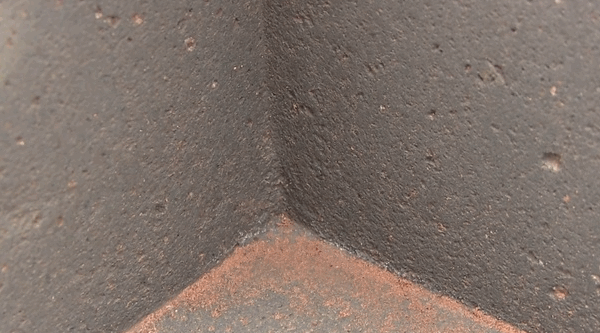
If chiseling would be your method of choice, why leave this particular corner flawed but not any others? When instead using articulated molds and filling them with a cement-like slurry, while one of the inserts is slightly damaged at the edge, this would produce exactly the effect seen in this block. And so Schuster was able to recreate this flaw using molds and cement.
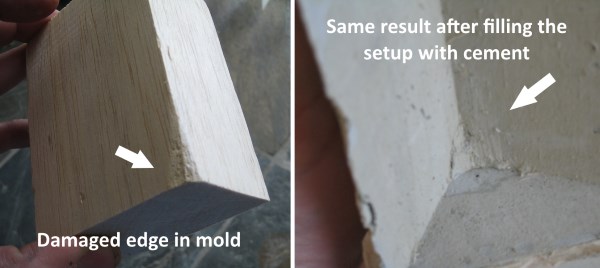
In order to help us visualize the process, I created a schematic highlighting the steps necessary to achieve the flawed corner. Click on the thumbnail for a larger version of the image.
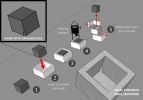
_____________________________________________________________________
Schuster's next example is the so-called Arrow Rock, an interesting triangular depression that can be seen in an andesite block at Puma Punku. It features a peculiar discoloration around its edges, a thin parting line extending from the top and bottom of the arrow and, lastly, a recess in the depression underneath the top right edge which would be incredibly difficult to achieve through chiseling.
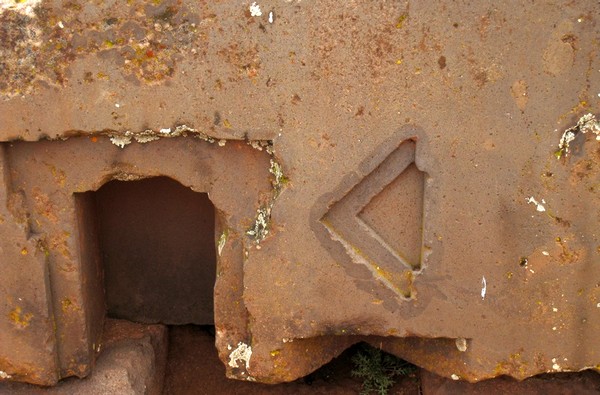
Click on the thumbnail below to see different perspectives and close ups of the triangular depressions, the parting lines described by Schuster are also highlighted in the larger image below:
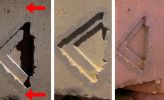
On his website, Schuster indicates how these features could be explained by using a molding process and a cement-like slurry. To illustrate this, he made a replica with wooden molds as shown in the slideshow below consisting of four images.
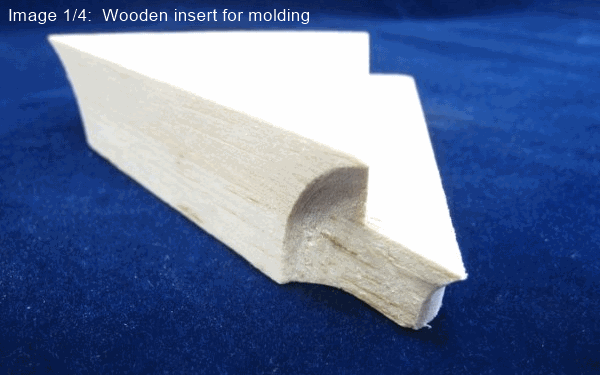
_____________________________________________________________________
The last example for possible molding techniques applied by the ancient builders is a large stone slab which appears to be a model for an even larger-scale megalthic construction that apparently hasn't been built (note the steps leading to the central pool). As Schuster indicates, from certain perspectices one can see faint parting lines across the slab. These lines can also be seen on other slabs at Puma Punku and they seem to be interconnected.
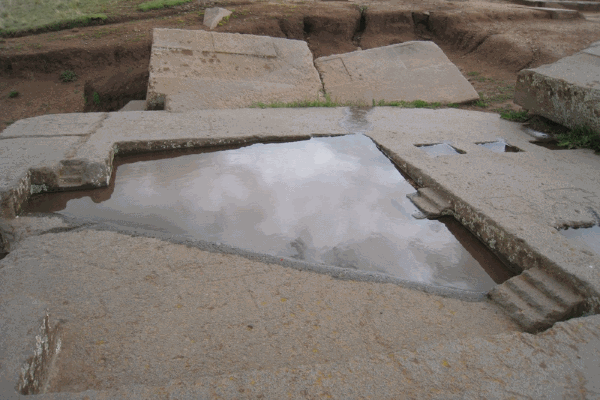
Of course one could now ask whether these marks were made at a later stage in an attempt to split these rocks and use the site as a quarry. But in that case, whoever might have attempted to do so, wouldn't have been very successful and why wouldn't they have done this in a more efficient manner by separating the stones step by step in a more limited area? For all we know, this wasn't the case and so these marks could indeed be parting lines where different molds were inserted. If this was the way they went about with regard to this slab, then we of course also have to ask: why not use one huge insert for the molding process instead of several pieces, similar to a huge puzzle? This could have been related to the material they used for the inserts, perhaps it was simply easier for them to work in this way? In any case, Schuster's approach delivers some food for thought here as well.
Here goes another slideshow (four images) with some impressions from Schuster's experiment aiming to recreate this slab using wooden molds, inserts and cement:
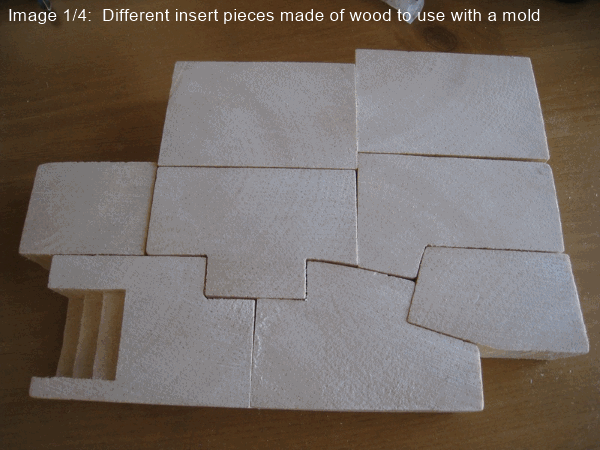
Schuster also has some interesting thoughts about stones found at Puma Punku featuring a number of small holes in regular distances and refers to them as tooling stones and explains in detail how they could have been used. In summary, I think Schuster builds a great case for an alternative method of stone working at Puma Punku, but it is only in combination with the microsopic analyses of the stones (see below) that his theory becomes really compelling and intriguing.
(continues in second post)
PART 2: GEOPOLYMER EVIDENCE BY J. DAVIDOVITS, L. HUAMAN AND R. DAVIDOVITS
Thanks to a recently published paper, we now also have scientific evidence to show that the andesidic volcanic rock used for the monuments at Puma Punku have a petrographic signature that differs considerably from the natural andesite that the ancient builders are said to have used according to previous theories.
The three authors of the paper collected samples and did a petrographic analysis using a scanning electron microscope (SEM) in order to determine the exact nature of the stones that the Puma Punku artifacts are sculpted from. In a nutshell, their analysis yielded the following results and insights:

Here goes the abstract of their paper:
And from the above they conclude:
If you prefer an executive summary of the details you can also watch this short video highlighting the main insights. The relevant part starts at the five minute mark but the link includes a timestamp that should take you right to the recap of the findings.
IMO it's also rather intriguing that the microsopic analysis reveals that there are no indications that the crystalline structure of the top stone layer (flat surface) has been destroyed through abrasive processes or chiseling:
And here is an overview of the results from the SEM analysis indicating the main components:
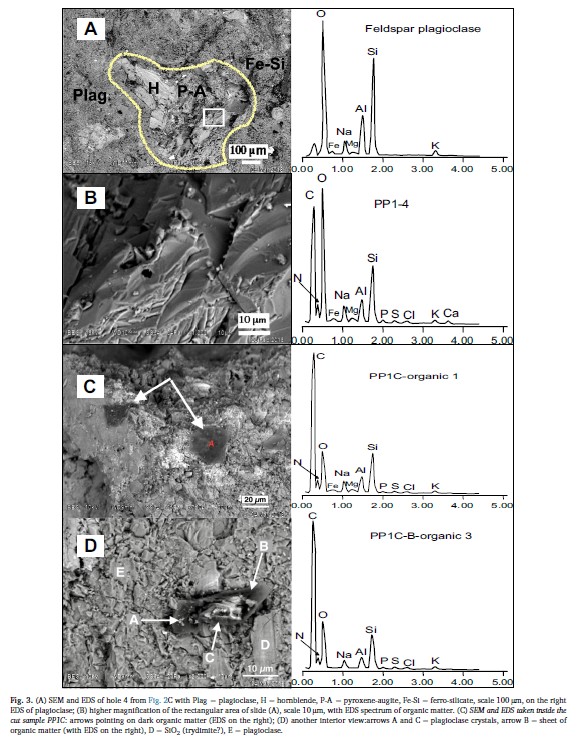
The authors further considered the possibility that the presence of organic material could have simply been caused by surface polution but they managed to rule this out by looking deeper into the samples (where the make up of the stone was exactly the same). According to the authors, further research is currently carried out to determine the specific makeup of the organic matter (ammonium-organic compound). The next step will be to gather enough sample material in order to implement C14 dating.
No matter where you stand on this issue, I personally think that this is an important step forward in trying to understand how the ancients were able to accomplish the feats we see in their magnificent stonework. And with the findings presented by Davidovits, Huaman and Schuster, a wholly new picture starts to emerge. Exciting times ahead, indeed!
Many thanks for reading up to here, I very much look forward to your comments and opinions...
Sources & Links:
-----------------------------------------------------------------
01. Ancient Geopolymer in South-American Monuments
02. Tiahuanaco Monuments Made of Geopolymer
03. E. Schuster: Introduction
04. E. Schuster: Molded vs. Chiseled Rocks
05. E. Schuster: The Arrow Rock
06. E. Schuster: The Kantatallita Slab
07. E. Schuster: The "H" Stone
08. E. Schuster: The Tooling Stones
09. E. Schuster: Using The Tooling Stones
10. Details about different molding techniques
11. Further information about geopolymers
12. Video with executive summary of the findings
13. Image source: Conquistadores in Puma Punku
14. Image source: Tiwanaku
15. Image source: Puma Punku stones with cross
16. David Pratt: Lost Civilizations of the Andes
17. The Ruins of Tihuanaco in the Highlands of Ancient Peru (Stübel, A.; Uhle. M.)
Thanks to a recently published paper, we now also have scientific evidence to show that the andesidic volcanic rock used for the monuments at Puma Punku have a petrographic signature that differs considerably from the natural andesite that the ancient builders are said to have used according to previous theories.
The three authors of the paper collected samples and did a petrographic analysis using a scanning electron microscope (SEM) in order to determine the exact nature of the stones that the Puma Punku artifacts are sculpted from. In a nutshell, their analysis yielded the following results and insights:

Here goes the abstract of their paper:
Ancient Organo-Mineral Geopolymer in South-American Monuments
A recent study has shown the presence of artificial construction materials in pre-Columbian monuments at Pumapunku-Tiwanaku, Bolivia. In addition to ancient geopolymer sandstone-concrete megalithic slabs, the Pumapunku site contains puzzling "H" structures made of andesitic volcanic stone. The SEM study of this gray andesite shows the presence of organic matter: carbon, nitrogen, and minerals: Na, Mg, Al, Si, P, S, Cl, K, Ca. Organic matter is very unusual, if not impossible in a solid volcanic stone and suggests ceramic-like man-made stone. Our research demonstrates that these architectural components manufactured 1400 years ago (ca. CE 600) were fashioned with a type of organo-mineral precursor.
And from the above they conclude:
It (...) supports the idea of artificial andesite stone. To make the organomineral precursor, the builders may have transported non-consolidated volcanic tuff, which is an andesite stony material having the consistence of sand from the Cerro Khapia volcano site, and added organo-mineral elements manufactured with local biomass.
If you prefer an executive summary of the details you can also watch this short video highlighting the main insights. The relevant part starts at the five minute mark but the link includes a timestamp that should take you right to the recap of the findings.
IMO it's also rather intriguing that the microsopic analysis reveals that there are no indications that the crystalline structure of the top stone layer (flat surface) has been destroyed through abrasive processes or chiseling:
The surface is very flat, without any trace of polishing action with abrasive grains nor cutting tools, but dotted with small holes that are 0.5–1mm in diameter and 0.2–0.5mm deep with clear edges.
And here is an overview of the results from the SEM analysis indicating the main components:

The authors further considered the possibility that the presence of organic material could have simply been caused by surface polution but they managed to rule this out by looking deeper into the samples (where the make up of the stone was exactly the same). According to the authors, further research is currently carried out to determine the specific makeup of the organic matter (ammonium-organic compound). The next step will be to gather enough sample material in order to implement C14 dating.
No matter where you stand on this issue, I personally think that this is an important step forward in trying to understand how the ancients were able to accomplish the feats we see in their magnificent stonework. And with the findings presented by Davidovits, Huaman and Schuster, a wholly new picture starts to emerge. Exciting times ahead, indeed!
Many thanks for reading up to here, I very much look forward to your comments and opinions...
Sources & Links:
-----------------------------------------------------------------
01. Ancient Geopolymer in South-American Monuments
02. Tiahuanaco Monuments Made of Geopolymer
03. E. Schuster: Introduction
04. E. Schuster: Molded vs. Chiseled Rocks
05. E. Schuster: The Arrow Rock
06. E. Schuster: The Kantatallita Slab
07. E. Schuster: The "H" Stone
08. E. Schuster: The Tooling Stones
09. E. Schuster: Using The Tooling Stones
10. Details about different molding techniques
11. Further information about geopolymers
12. Video with executive summary of the findings
13. Image source: Conquistadores in Puma Punku
14. Image source: Tiwanaku
15. Image source: Puma Punku stones with cross
16. David Pratt: Lost Civilizations of the Andes
17. The Ruins of Tihuanaco in the Highlands of Ancient Peru (Stübel, A.; Uhle. M.)
Superb thread, jeep. Looking forward to digging in deeper. Thank you for bringing it to us.
S&F for an excellent thread!
Imagine the immense amount of time that would be saved by using molds and some type of geopolymer substance to create these objects. I can only imagine that this would cut the length of time to complete construction down drastically. Just a guess, but possibly 10% of the time as opposed to using saws, chisels and polishing techniques to shape these megalithic objects. The latter has never made any sense in large scale construction.
Imagine the immense amount of time that would be saved by using molds and some type of geopolymer substance to create these objects. I can only imagine that this would cut the length of time to complete construction down drastically. Just a guess, but possibly 10% of the time as opposed to using saws, chisels and polishing techniques to shape these megalithic objects. The latter has never made any sense in large scale construction.
edit on 17-3-2019 by KKLOCO because: Sp
Very interesting stuff here.
I have never beleived that the hammer and chisle method alone was used in creating these artifacts. Having been in the manufacturing industry my entire life, I find the indication of "parting lines" quite intriguing. It would explain a lot, and points strongly to a cast/mold process.
Excellent OP. S&F
I have never beleived that the hammer and chisle method alone was used in creating these artifacts. Having been in the manufacturing industry my entire life, I find the indication of "parting lines" quite intriguing. It would explain a lot, and points strongly to a cast/mold process.
Excellent OP. S&F
a reply to: jeep3r
Very intriguing, though I didn’t see the part where you explain how they softened stone as the title of your thread suggests. Using geo polymers is a good explanation for some of the ancient stone work but it doesn’t explain how they cut and worked natural stone which we see plenty of evidence for that they did.
So with that in mind I’ll return to this thread with a good explanation for just that.
Very intriguing, though I didn’t see the part where you explain how they softened stone as the title of your thread suggests. Using geo polymers is a good explanation for some of the ancient stone work but it doesn’t explain how they cut and worked natural stone which we see plenty of evidence for that they did.
So with that in mind I’ll return to this thread with a good explanation for just that.
a reply to: surfer_soul
Technically speaking I would say you're right. The assumption in the OP is that they used a sand like volcanic tuff material in combination with organo-mineral elements manufactured with local biomass in order to create a geopolymer slurry that could be applied like we use cement today.
Technically speaking I would say you're right. The assumption in the OP is that they used a sand like volcanic tuff material in combination with organo-mineral elements manufactured with local biomass in order to create a geopolymer slurry that could be applied like we use cement today.
a reply to: jeep3r
I’m no expert, but I’m going to throw this out there anyways.
As an example, granite has a melting point of approximately 2300 F. Is it outside the realm of possibility that the ancients had the techniques to accomplish this? Instead of making a geopolymer substance, did they just melt pre-existing rock?
I’m sure there would be some signs of chemical changes in the rock, if this was the case.
I’m no expert, but I’m going to throw this out there anyways.
As an example, granite has a melting point of approximately 2300 F. Is it outside the realm of possibility that the ancients had the techniques to accomplish this? Instead of making a geopolymer substance, did they just melt pre-existing rock?
I’m sure there would be some signs of chemical changes in the rock, if this was the case.
Thanks for your well-presented work, yes I believe you and others are on the right track with this. I have seen what at a first glance is rock, but
once examined it has unusual shapes which leads one to think that yes indeed. Back in the day, people or some people knew how to create a moulded
concrete block.
Trouble is that we have such a strong imprint in our minds, that the further we go back in time the less we knew how to do anything halfway intelligent. Here is a photo I took from a supposed Roman site and although it is not like your chosen site, it does have some living evidence that in other times they knew how to make moulds etc.
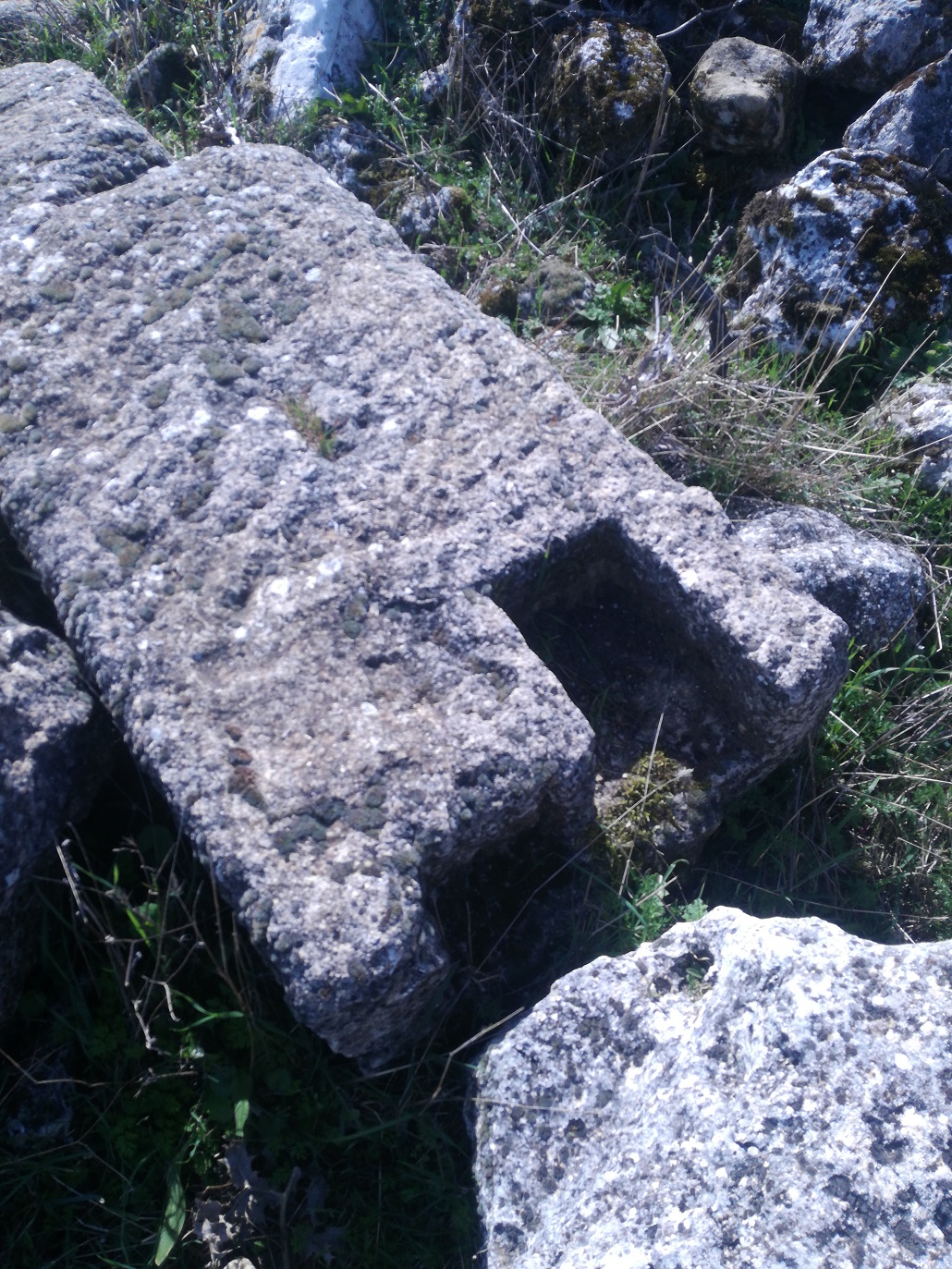
a reply to: jeep3r
Trouble is that we have such a strong imprint in our minds, that the further we go back in time the less we knew how to do anything halfway intelligent. Here is a photo I took from a supposed Roman site and although it is not like your chosen site, it does have some living evidence that in other times they knew how to make moulds etc.

a reply to: jeep3r
edit on 17-3-2019 by ancientthunder because: missing words
a reply to: jeep3r
OK here is an extract and a link to a paper by Helmut Tributsch. Detailing how an acidic substance was used corode and soften the stones into a silca like gel known as red mud, for shaping and smoothing hard stones as well as fitting them together. Explaining the perfect fitting joints we see on so much of the stone work.
PDF
I highly reccomend reading the paper and the authors conclusions in full. Also from the same youtube channel you posted the geo polymer video from, is another video explaining the same authors research. Although I find the narators voice grating, it is a very good explanation with lot's of images showing just what the author is talking about. As a picture speaks a thousand words I highly reccomend veiwing the video as well.
www.youtube.com...
OK here is an extract and a link to a paper by Helmut Tributsch. Detailing how an acidic substance was used corode and soften the stones into a silca like gel known as red mud, for shaping and smoothing hard stones as well as fitting them together. Explaining the perfect fitting joints we see on so much of the stone work.
A high level of understanding has consequently been reached of the diverse working steps and tools ap- plied. An exception is the reddish mud, “ llancac alpa ” in the quechua language, and the “ gold ”, mentioned by early chroniclers as mortar which fitted the stones and later disappeared. Such tech-niques were related to folklore and not taken seriously. This study tries to understand them and the question was asked: did Inca builders have access to very acid mud? They did, and used the acid mud from their mines, which generated sulphuric acid through bacterial oxidation of pyrite (fools gold). It reaches an acidity of up to pH = 0.5, which is 10^4 times more acid than humic acid which is known to weather silica containing rocks via silica gel to the clay mineral kaolin. This acid mud allowed dissolving and softening the rock material superficially to a viscoelastic silica gel. The process could be further enhanced more than tenfold by addition of (oxalic acid containing) plant sap, a skill suggested from popular tradition
I highly reccomend reading the paper and the authors conclusions in full. Also from the same youtube channel you posted the geo polymer video from, is another video explaining the same authors research. Although I find the narators voice grating, it is a very good explanation with lot's of images showing just what the author is talking about. As a picture speaks a thousand words I highly reccomend veiwing the video as well.
www.youtube.com...
edit on 17-3-2019 by surfer_soul because: (no reason given)
edit on
17-3-2019 by surfer_soul because: (no reason given)
Sorry, but your explanation does not fit the evidence. The implication of moulding would be that every H-block would look the same since they came
from the same one (or few) moulds. Unfortunately for your theory, the several dozen examples that exist are ALL different - they were made
individually. Your theory presumes ones of the myths of Puma Punku, namely, that the H-blocks were mass-produced somehow. On the contrary,they show
small differences indicating that they were made individually and certainly NOT from one or two slightly different moulds. One would expect to find at
least two that are identical. Instead, one encounters NONE that look the same. As for the one with a dodgy inside corner, well, that one made by an
apprentice got past the quality inspector, didn't it? I mean, not even the Pumu Punku craftsmen were perfect!
edit on 17-3-2019 by micpsi
because: (no reason given)
a reply to: micpsi
That's an interesting point, but when considering the evidence for a cement-like slurry that the builders used it would still be a whole lot easier and less time-consuming to use individual molds than to chisel away at the stones.
Maybe it wasn't a problem to make the blocks in such an individual fashion, perhaps even intentional? I think this would also depend on other aspects of the manufacturing process. Apart from that, I'm not aware of any claim that they were mass-produced.
That's an interesting point, but when considering the evidence for a cement-like slurry that the builders used it would still be a whole lot easier and less time-consuming to use individual molds than to chisel away at the stones.
Maybe it wasn't a problem to make the blocks in such an individual fashion, perhaps even intentional? I think this would also depend on other aspects of the manufacturing process. Apart from that, I'm not aware of any claim that they were mass-produced.
originally posted by: surfer_soul
I highly reccomend reading the paper and the authors conclusions in full.
Thanks for posting the link to the PDF, I like how Tributsch goes from inca folklore to actual experiments trying to see whether any acidic solution could have been used. The following excerpt is quite intriguing:
2. 7. Evidence for chemical treatment of Inca stone walls
A small sample from the Peruvian Inca site called Tetecaca has been collected from a limestone block showing a smooth overlayer. This smooth layer has been analized by the University of Utrecht, Holland. The surface layer, approximately 10 micrometer thick on top of the limestone (besides of Ca, C, and O showing only low amounts of trace elements) showed high concentrations of Si, Al and Mg. This indicates that a special material layer on silica-basis has been superposed.
Amazing read, just going through some of the sources now.
You and Slayer69 were the main reason I got hooked to this site thanks to your talent of relating information about ancient civilizations in a way that sparks curiosity and wonder. Thanks for that.
You and Slayer69 were the main reason I got hooked to this site thanks to your talent of relating information about ancient civilizations in a way that sparks curiosity and wonder. Thanks for that.
a reply to: jeep3r
Thanks for some awesome content
I would really like to see this taken to the next step: demonstrate the process. Yeah, I understand the researchers are not there yet. They seem to be providing observations against cutting and pro molding. How that molding was accomplished, still to be determined.
As another poster beat me to it, if they were molds I would expect some repeats. Very consistent blocks and/or imperfections. I have no data to decide either way.
I agree molding would be a waaaaay easier approach to the end product.
Thanks for some awesome content
I would really like to see this taken to the next step: demonstrate the process. Yeah, I understand the researchers are not there yet. They seem to be providing observations against cutting and pro molding. How that molding was accomplished, still to be determined.
As another poster beat me to it, if they were molds I would expect some repeats. Very consistent blocks and/or imperfections. I have no data to decide either way.
I agree molding would be a waaaaay easier approach to the end product.
Think I have been down this road a few times. Something to do with a special kind of bird and their saliva mixed with a plant or berry. Thread was
posted about this a few days ago and a few years ago.
Thanks. IMO the dating is going to be crucial here. What I'm thinking here is, what if the C14 dates show 12,000 BC?
I find it reasonable.
Not like the Europeans had some sort of exclusivity patent on renaissance masonry.
Evidence of your technological advancements is probably hard to come by. If your methods of passing on knowledge are word of mouth, and not recorded in a way that someone from the future could decipher.
Not like the Europeans had some sort of exclusivity patent on renaissance masonry.
Evidence of your technological advancements is probably hard to come by. If your methods of passing on knowledge are word of mouth, and not recorded in a way that someone from the future could decipher.
new topics
-
A call to repentance—God is patient, but His patience does not abide forever.
Religion, Faith, And Theology: 7 hours ago -
My Pet Elephant For A Day…
Short Stories: 7 hours ago -
Congress 2024 - We do not want me in our ladies rooms
US Political Madness: 7 hours ago
top topics
-
A Question for You on the Left
Political Ideology: 14 hours ago, 18 flags -
Dr Cambell talking about using worm meds for cancer
Medical Issues & Conspiracies: 12 hours ago, 14 flags -
Looks like Biden kicked off WWIII and Putin threatening nukes to retaliate
World War Three: 15 hours ago, 9 flags -
Congress 2024 - We do not want me in our ladies rooms
US Political Madness: 7 hours ago, 8 flags -
My Pet Elephant For A Day…
Short Stories: 7 hours ago, 6 flags -
Words of Wisdom from the Dear Leader - Transcribed for the World
Regional Politics: 14 hours ago, 4 flags -
A call to repentance—God is patient, but His patience does not abide forever.
Religion, Faith, And Theology: 7 hours ago, 2 flags
active topics
-
-@TH3WH17ERABB17- -Q- ---TIME TO SHOW THE WORLD--- -Part- --44--
Dissecting Disinformation • 3314 • : RelSciHistItSufi -
DefCon Teetering on Escalation
World War Three • 43 • : NorthOS -
A Question for You on the Left
Political Ideology • 40 • : atsalex2 -
Congress 2024 - We do not want me in our ladies rooms
US Political Madness • 4 • : matafuchs -
President-Elect DONALD TRUMP's 2nd-Term Administration Takes Shape.
Political Ideology • 224 • : WeMustCare -
Incoming TRUMP Admin will Declare a National Emergency to Mass Deport People Here Illegally.
Social Issues and Civil Unrest • 113 • : WeMustCare -
Former DOJ charged with defrauding Rep. Matt Gaetz’s family over sex-crimes investigation
Propaganda Mill • 38 • : WeMustCare -
President-elect TRUMP Picks MATT GAETZ for his ATTORNEY GENERAL - High Level PANIC Ensues.
2024 Elections • 104 • : WeMustCare -
WATCH LIVE: US Congress hearing on UFOs, unidentified anomalous phenomena
Aliens and UFOs • 137 • : WeMustCare -
My Pet Elephant For A Day…
Short Stories • 8 • : JJproductions
